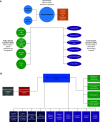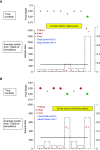The REMAP-CAP (Randomized Embedded Multifactorial Adaptive Platform for Community-acquired Pneumonia) Study. Rationale and Design
- PMID: 32267771
- PMCID: PMC7328186
- DOI: 10.1513/AnnalsATS.202003-192SD
The REMAP-CAP (Randomized Embedded Multifactorial Adaptive Platform for Community-acquired Pneumonia) Study. Rationale and Design
Abstract
There is broad interest in improved methods to generate robust evidence regarding best practice, especially in settings where patient conditions are heterogenous and require multiple concomitant therapies. Here, we present the rationale and design of a large, international trial that combines features of adaptive platform trials with pragmatic point-of-care trials to determine best treatment strategies for patients admitted to an intensive care unit with severe community-acquired pneumonia. The trial uses a novel design, entitled "a randomized embedded multifactorial adaptive platform." The design has five key features: 1) randomization, allowing robust causal inference; 2) embedding of study procedures into routine care processes, facilitating enrollment, trial efficiency, and generalizability; 3) a multifactorial statistical model comparing multiple interventions across multiple patient subgroups; 4) response-adaptive randomization with preferential assignment to those interventions that appear most favorable; and 5) a platform structured to permit continuous, potentially perpetual enrollment beyond the evaluation of the initial treatments. The trial randomizes patients to multiple interventions within four treatment domains: antibiotics, antiviral therapy for influenza, host immunomodulation with extended macrolide therapy, and alternative corticosteroid regimens, representing 240 treatment regimens. The trial generates estimates of superiority, inferiority, and equivalence between regimens on the primary outcome of 90-day mortality, stratified by presence or absence of concomitant shock and proven or suspected influenza infection. The trial will also compare ventilatory and oxygenation strategies, and has capacity to address additional questions rapidly during pandemic respiratory infections. As of January 2020, REMAP-CAP (Randomized Embedded Multifactorial Adaptive Platform for Community-acquired Pneumonia) was approved and enrolling patients in 52 intensive care units in 13 countries on 3 continents. In February, it transitioned into pandemic mode with several design adaptations for coronavirus disease 2019. Lessons learned from the design and conduct of this trial should aid in dissemination of similar platform initiatives in other disease areas.Clinical trial registered with www.clinicaltrials.gov (NCT02735707).
Keywords: Bayesian adaptive; community-acquired pneumonia; coronavirus disease 2019; master protocol; platform trial; randomized clinical trial.
Figures



References
-
- Cochrane AL.Effectiveness and efficiency: random reflections on health services.London: Nuffield Provincial Hospitals Trust; 1972 - PubMed
-
- Angus DC. Fusing randomized trials with big data: the key to self-learning health care systems? JAMA. 2015;314:767–768. - PubMed
-
- Angus DC.Optimizing the trade-off between learning and doing in a pandemic JAMA[online ahead of print] 30 Mar 2020 - PubMed
-
- Musher DM, Thorner AR. Community-acquired pneumonia. N Engl J Med. 2014;371:1619–1628. - PubMed
-
- Bjerre LM, Verheij TJ, Kochen MM. Antibiotics for community acquired pneumonia in adult outpatients. Cochrane Database Syst Rev. 2009;(4):CD002109. - PubMed
Publication types
MeSH terms
Substances
Associated data
Grants and funding
LinkOut - more resources
Full Text Sources
Medical
Research Materials
Miscellaneous

